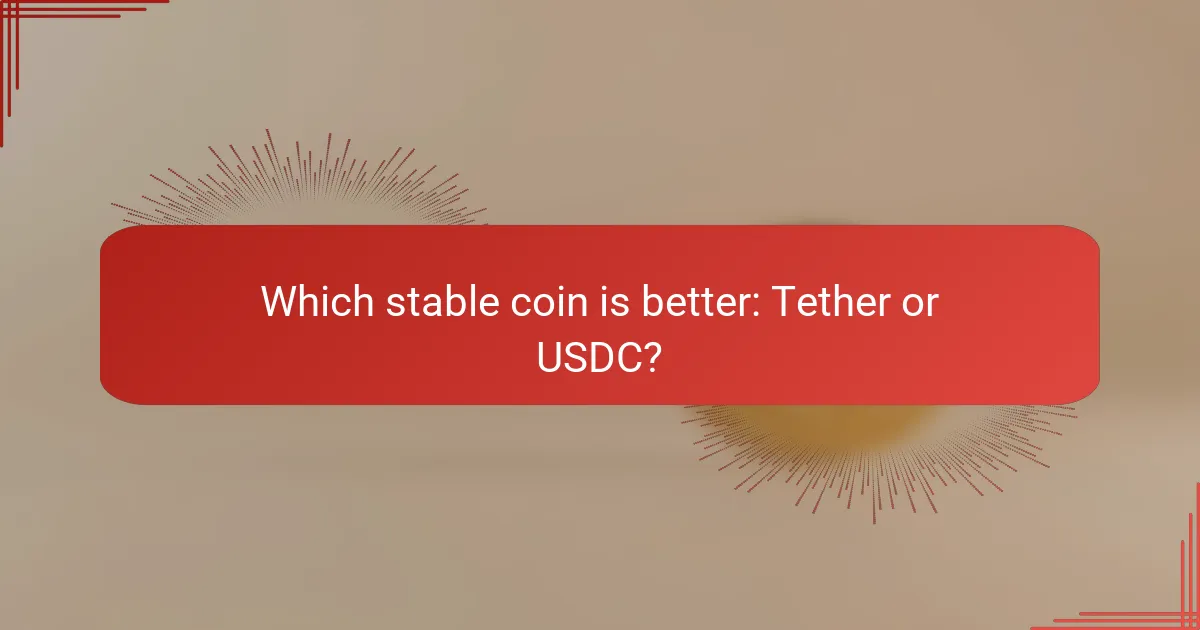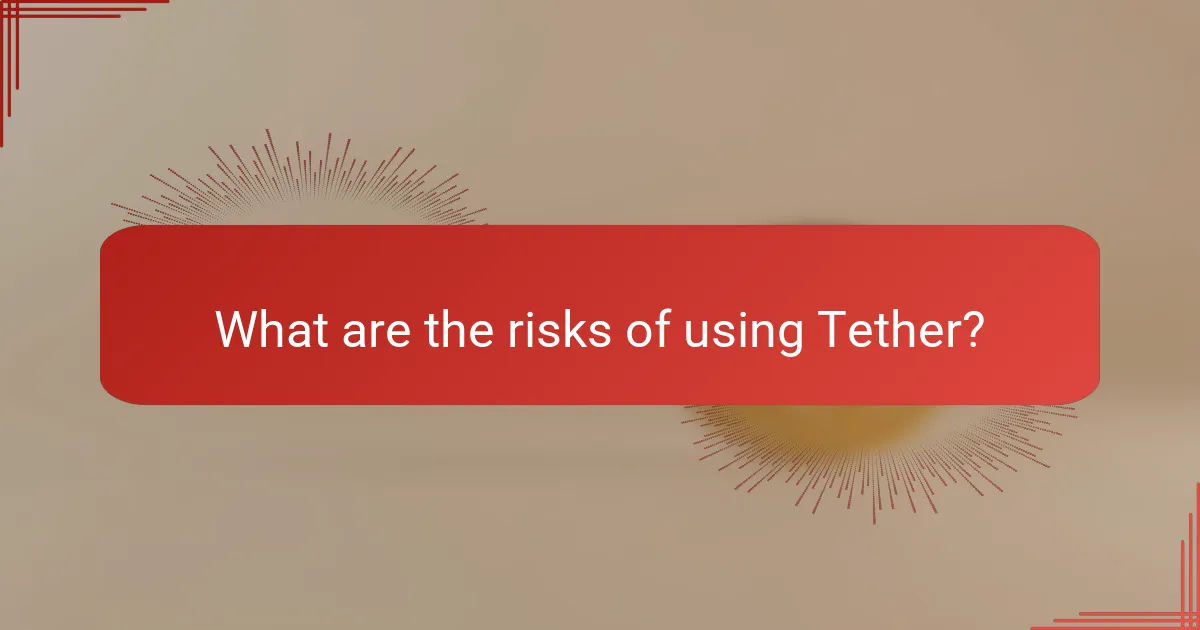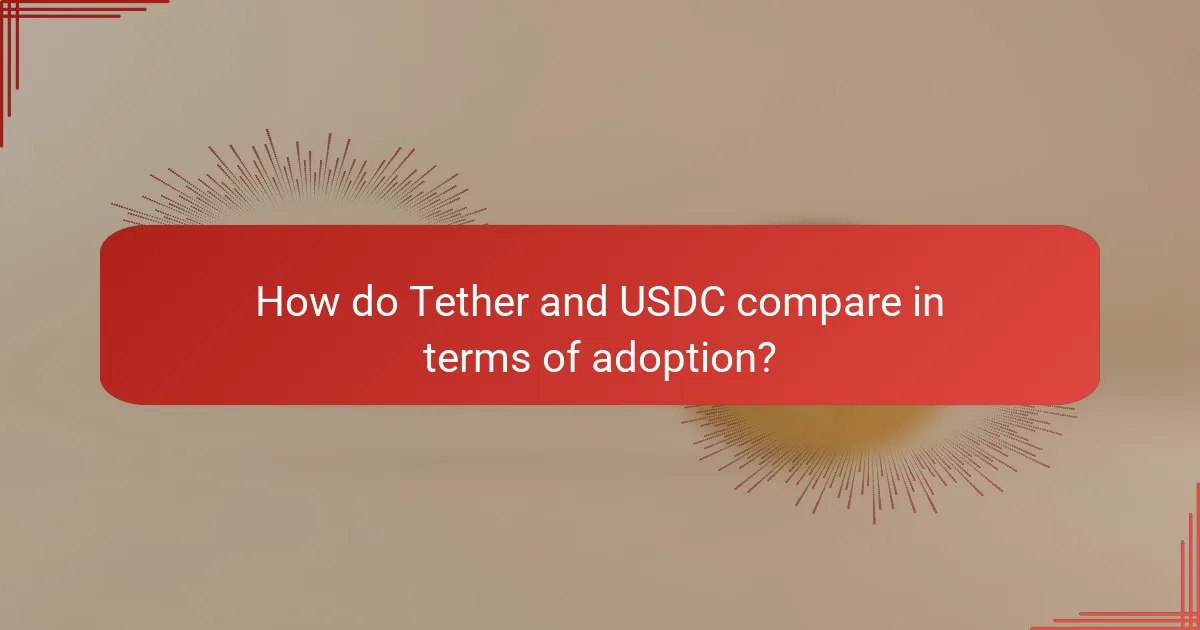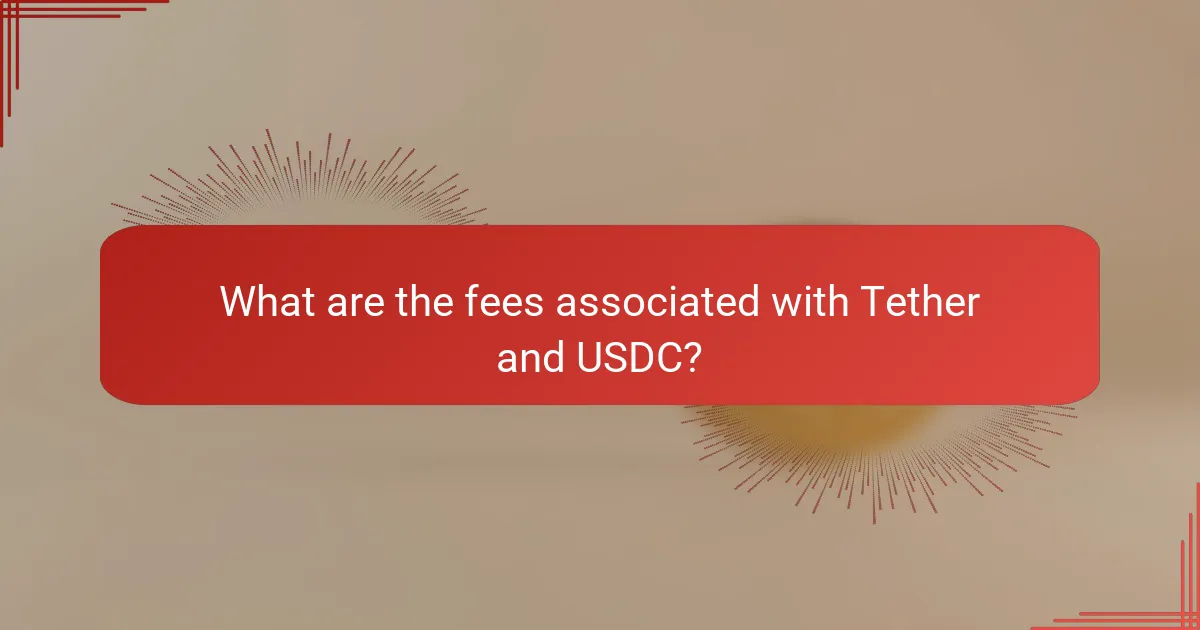When deciding between Tether (USDT) and USD Coin (USDC), it’s essential to consider factors like liquidity, regulatory compliance, and the specific use case. Tether is favored for its high liquidity and speed in trading, while USDC stands out for its transparency and adherence to regulatory standards, making it suitable for environments that prioritize trust and compliance.

Which stable coin is better: Tether or USDC?
Choosing between Tether (USDT) and USD Coin (USDC) depends on your needs for liquidity, regulatory compliance, and institutional acceptance. Tether generally offers higher liquidity, while USDC is recognized for its transparency and regulatory adherence.
Tether offers higher liquidity
Tether is known for its high liquidity, making it easier to buy and sell on various exchanges. This liquidity is crucial for traders who need to execute large transactions quickly without significantly impacting the price.
With Tether, you can often find it listed on nearly all major cryptocurrency exchanges, which enhances its accessibility. This widespread availability means that traders can convert USDT to other cryptocurrencies or fiat currencies with minimal friction.
USDC provides regulatory transparency
USDC stands out for its commitment to regulatory transparency, as it undergoes regular audits by third-party firms. This practice helps ensure that each USDC is backed by a corresponding US dollar, fostering trust among users.
For individuals and businesses concerned about compliance, USDC’s adherence to regulations can be a significant advantage. It is often favored in environments where regulatory scrutiny is high, making it a safer choice for those who prioritize transparency.
Tether has a longer market history
Tether has been in the market since 2014, giving it a longer track record compared to USDC, which launched in 2018. This history can provide a sense of stability and reliability for users who prefer established options.
The longevity of Tether means it has weathered various market conditions, which can be reassuring for traders and investors. However, it’s essential to consider the evolving regulatory landscape and how it may impact Tether’s operations in the future.
USDC is favored by institutions
USDC is increasingly preferred by institutional investors and companies due to its regulatory compliance and transparency. Many financial institutions are integrating USDC into their operations, recognizing its potential for stable transactions.
For businesses looking to adopt cryptocurrency for payments or treasury management, USDC’s reputation as a compliant and stable asset makes it an attractive option. This institutional backing can enhance its credibility in the market.

When should I use Tether?
Tether is often preferred for transactions that require speed and efficiency, particularly in high-volume trading environments. Its widespread acceptance and stable value make it a practical choice for traders looking to capitalize on market fluctuations.
For high-volume trading
Tether is ideal for high-volume trading due to its liquidity and fast transaction times. Traders can quickly move large amounts of capital without significant price slippage, which is crucial in volatile markets. For example, during rapid market movements, using Tether can help execute trades in seconds, minimizing the risk of losing value.
Many exchanges support Tether, allowing traders to easily convert it to other cryptocurrencies or fiat currencies. This accessibility ensures that traders can enter and exit positions swiftly, making it a go-to option for those engaging in frequent trades.
When liquidity is critical
Liquidity is a key factor when using Tether, especially in scenarios where immediate access to funds is necessary. Tether’s peg to the US dollar provides stability, making it a reliable option for maintaining value during market fluctuations. This stability is essential for traders who need to ensure their assets remain liquid.
In situations where quick conversions are required, such as during market corrections or sudden price spikes, Tether allows for seamless transitions between assets. Traders should consider using Tether to safeguard their investments and maintain liquidity, especially in fast-paced trading environments.

When should I use USDC?
USDC is ideal for transactions that require regulatory compliance and a stable value. Its backing by reserves and adherence to strict standards make it a preferred choice in environments where transparency and trust are paramount.
For compliance-focused transactions
USDC is designed with compliance in mind, making it suitable for businesses that need to adhere to financial regulations. Its issuance is governed by a set of standards that ensure each token is backed by a corresponding US dollar, providing a clear audit trail.
Using USDC can help businesses avoid regulatory pitfalls, especially in jurisdictions with strict cryptocurrency laws. For example, companies operating in the EU or the US may find USDC a safer option for transactions that require proof of reserves and adherence to anti-money laundering (AML) regulations.
When seeking stability in regulated environments
In regulated environments, USDC offers a high level of stability due to its dollar-pegged nature and regular audits. This stability is crucial for businesses that need to manage cash flow without the volatility associated with other cryptocurrencies.
For instance, companies that operate in sectors like finance or healthcare, where price fluctuations can impact budgeting and forecasting, may prefer USDC. By using USDC, these businesses can maintain a consistent value in their transactions, reducing the risk associated with price swings.

What are the risks of using Tether?
Using Tether carries several risks, primarily related to its reserve backing and regulatory environment. Investors should be aware of potential issues that could affect the stability and reliability of this stablecoin.
Concerns over reserve transparency
A significant risk associated with Tether is the lack of transparency regarding its reserves. While Tether claims that each USDT is backed by a corresponding US dollar, the details of these reserves have often been questioned. In the past, Tether has faced scrutiny for not providing regular, comprehensive audits of its holdings.
This opacity can lead to uncertainty among users, as it raises concerns about whether Tether can maintain its peg to the US dollar in times of market stress. Investors should consider the implications of this lack of transparency when deciding to use Tether.
Potential regulatory scrutiny
Tether is also subject to potential regulatory scrutiny, which can pose risks to its users. Regulatory bodies in various jurisdictions, including the United States, have raised concerns about the operations of stablecoins like Tether, particularly regarding consumer protection and financial stability.
Increased regulation could lead to changes in how Tether operates, potentially affecting its liquidity and usability. Users should stay informed about regulatory developments and consider the implications these may have on their investments in Tether.

What are the risks of using USDC?
USDC, while generally considered a stable and reliable digital currency, carries specific risks that users should be aware of. These include lower liquidity compared to competitors like Tether and potential regulatory compliance issues that may affect its usability in certain jurisdictions.
Lower liquidity compared to Tether
One significant risk of using USDC is its lower liquidity when compared to Tether (USDT). Liquidity refers to how easily an asset can be bought or sold without affecting its price. In high-volume trading situations, USDC may not be as readily available, which could lead to slippage or delays in transactions.
For traders, this means that during peak trading hours or market volatility, converting USDC to other cryptocurrencies or fiat may take longer or result in less favorable rates. Users should consider their trading volume and timing when opting for USDC over Tether.
Regulatory compliance may limit use
USDC is subject to stringent regulatory compliance, which can limit its use in certain scenarios. While this compliance can enhance trust and security, it may also restrict access for users in regions with strict cryptocurrency regulations. For instance, users in countries with heavy financial oversight might find it challenging to use USDC for transactions.
Additionally, regulatory changes could impact the availability of USDC in the future. Users should stay informed about local regulations and be prepared for potential restrictions that could affect their ability to use USDC effectively.

How do Tether and USDC compare in terms of adoption?
Tether (USDT) is currently more widely adopted than USD Coin (USDC), primarily due to its early entry into the market and extensive use across various exchanges. However, USDC is rapidly gaining popularity, particularly in decentralized finance (DeFi) applications, which may influence future adoption trends.
Tether is widely accepted across exchanges
Tether is the most widely used stablecoin in the cryptocurrency market, accepted by nearly all major exchanges. Its extensive integration allows users to trade, invest, and transfer funds seamlessly across platforms, making it a go-to choice for many traders.
Due to its high liquidity, Tether is often preferred for trading pairs, allowing users to quickly convert between cryptocurrencies and fiat. This widespread acceptance can be advantageous for those looking to execute trades rapidly without significant slippage.
USDC is gaining traction in DeFi
USDC is increasingly favored in the DeFi space, where its transparency and regulatory compliance appeal to users. Many DeFi platforms now support USDC for lending, borrowing, and yield farming, which enhances its utility beyond simple transactions.
As more projects adopt USDC, its market presence is expected to grow. Users interested in participating in DeFi should consider USDC for its stability and the backing by regulated financial institutions, which can provide an added layer of trust.

What are the fees associated with Tether and USDC?
The fees associated with Tether (USDT) and USD Coin (USDC) can vary significantly based on the platform used for transactions. Generally, Tether fees depend on the exchange, while USDC typically has more standardized fees across platforms.
Tether fees vary by exchange
Tether fees can differ widely depending on the exchange where you trade. Some platforms may charge a flat fee for transactions, while others might impose a percentage-based fee. For example, fees can range from 0.1% to 1% of the transaction value, depending on the exchange’s policies.
Additionally, some exchanges may offer promotions or lower fees for high-volume traders. It’s essential to compare the fee structures of different exchanges before making a trade to ensure you are getting the best deal.
USDC fees are generally consistent
USDC fees tend to be more uniform across various platforms, often falling within a range of 0.1% to 0.5% for transactions. Many exchanges have adopted similar fee structures for USDC due to its regulatory compliance and backing by reputable financial institutions.
When using USDC, it’s advisable to check for any additional fees related to deposits or withdrawals, as these can impact the overall cost of transactions. Some platforms may offer fee-free transactions for USDC under specific conditions, such as using their native wallets.


